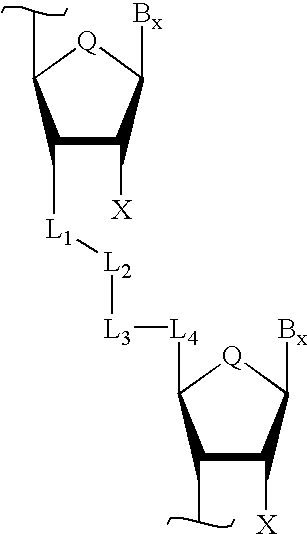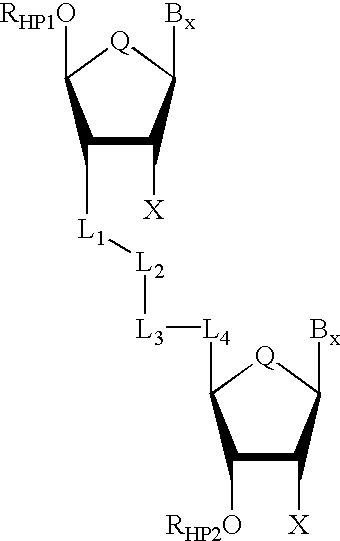Backbone-modified oligonucleotide analogs and methods for using same
a technology of backbone and oligonucleotide, which is applied in the field of backbone-modified oligonucleotide analogs and methods for using same, can solve the problem that material is no longer a true nucleic acid species, and achieve the effect of improving the pharmacokinetic improving the pharmacodynamic properties of an oligonucleotid
- Summary
- Abstract
- Description
- Claims
- Application Information
AI Technical Summary
Benefits of technology
Problems solved by technology
Method used
Image
Examples
example 1
[0109] Synthesis of CPG-Bound Nucleosides; Diphenylimidazolidino Protected 3'-aldehydic Thymidine and 5'-dedoxy-5'-hydrazino-thymidine.
[0110] CPG-bound thymidine (30 micromoles of thymidine on one gram of CPG support, ABI, Foster City, Calif.) is treated at ambient temperature with a mixture of DMSO, benzene, DCC, pyridine, and trifluoroacetic acid (15 ml / 15 ml / 2.48 g / 0.4 ml / 0.2 ml, similar to the oxidation procedure of Pfitzer, K. E. and J. G. Moffatt, Journal of American Chemical Society 85:3027 (1963), to provide 5'-aldehydic nucleosides. The mixture is filtered after storing overnight. The support is washed with oxalic acid (1.3 g in 5 ml benzene / DMSO, 1 to 1) and treated with 1,2-dianilinoethylene (3.0 g) for one hour, filtered, and washed with acetonitrile to afford the 5'-diphenylimidazolidino protected 5'-aldehydic thymidine. Treatment of the support-bound 5'-aldehydo thymidine with a solution of hydrazine hydrate / sodium cyanoborohydrate in acetonitrile provides CPG-3'-bo...
example 2
[0111] Synthesis of 5'-diphenylimidazolidino Protected-3'-deoxy-3'-C-hydra-sinomethyl Thymidine.
[0112] Commercially available 3'-O-acetylthymidine was oxidized and subsequently protected as its N,N-diphenylethylenediamine derivative (1,3-diphenylimidazolidino). This provides the known 5'-deoxy-51-diphenylimidazolidino-3,-acetylthymidine. Pfitzer, K. E. and J. G. Moffatt, Journal of American Chemical Society 85:3027 (1963). Hydrolysis of this material was achieved by methanolic ammonia treatment at ambient temperature for 15 hours. 5'-Deoxy-5'-diphenylimidazolidinothy-midine (4.5 g) was dissolved in DMF (100 ml) and treated with triphenylmethyl phosphonium iodide at room temperature for 15 hours. The solvent was removed under reduced pressure and the resulting residue recrystallized from methanol to provide the 3'-deoxy-3'-iodo derivative.
[0113] The 3'-deoxy-3'-iodo-5'-diphenylimidazolino thymidine was dissolved in toluene and treated with hexamethylditin, t-butylisonitrile, and AIBN...
example 3
[0114] Synthesis of Uniform Mothylneahydrazine Linked Oligonucloosidos Via an Applied Biosystems Inc 380B DNA Synthesizers
[0115] CPG-bound thymidine with a diphenylimidazolidino protected 5'-aldehyde that will become the 3'-terminal nucleoside is placed in an Applied Biosystems, Inc. (ABI) column (250 mg, 10 micromoles of bound nucleoside) and attached to an ABI 380B automated DNA Synthesizer. The automated (computer controlled) steps of a cycle that are required to couple a desmethyl nucleoside unit to the growing chain are as follows.
1 STEP REAGENT OR SOLVENT MIXTURE TIME (min:sec) 1 3% DCA in dichloroethane 3:00 2 Dichloroethane wash 1:30 3 5'-Deoxy-5'-(1,3-diphenylimid- 2:50 azolidino)-3'-deoxy-3'-C--methylene hydrazine nucleoside (the second nucleoside); 20 micromoles in 30 ml of acetonitrile 4 Sodium borohydride (50 micromole in 3:00 1:1 THF / EtOH, 50 ml) 5 Dichloroethane wash 2:00 6 Recycle starting at step 1 (acid wash) 3:00
[0116] This procedure yields as its product nucleosi...
PUM
| Property | Measurement | Unit |
|---|---|---|
| Structure | aaaaa | aaaaa |
| Electrical resistance | aaaaa | aaaaa |
| Affinity | aaaaa | aaaaa |
Abstract
Description
Claims
Application Information
 Login to View More
Login to View More - R&D
- Intellectual Property
- Life Sciences
- Materials
- Tech Scout
- Unparalleled Data Quality
- Higher Quality Content
- 60% Fewer Hallucinations
Browse by: Latest US Patents, China's latest patents, Technical Efficacy Thesaurus, Application Domain, Technology Topic, Popular Technical Reports.
© 2025 PatSnap. All rights reserved.Legal|Privacy policy|Modern Slavery Act Transparency Statement|Sitemap|About US| Contact US: help@patsnap.com



